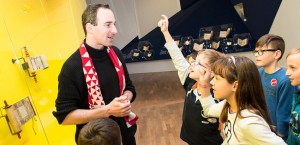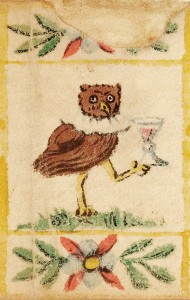The Jewish Museum Hosts “Lyrix”
 At the invitation of German Cultural Radio, schoolchildren appeared at the Jewish Museum Berlin on 13 June 2014 to write poetry with professionals from the literature scene. The theme was partnership. They turned for inspiration to a ketubah (marriage contract) from the current special exhibition “The Creation of the World” and the poem “marriage” by Kathrin Schmidt (which you can see in the original German on the Lyrix page of the radio’s website).
At the invitation of German Cultural Radio, schoolchildren appeared at the Jewish Museum Berlin on 13 June 2014 to write poetry with professionals from the literature scene. The theme was partnership. They turned for inspiration to a ketubah (marriage contract) from the current special exhibition “The Creation of the World” and the poem “marriage” by Kathrin Schmidt (which you can see in the original German on the Lyrix page of the radio’s website).
Poet Max Czollek guided the students, gathered in a seminar room, to free associate with the term ‘partnership.’ Words came up like marriage, devotion, trust and love (both very frequently), loyalty, and so on. But those most obvious associations aren’t actually what we need for poetry. What do we need then?
A few rooms further down, poet Nadja Küchenmeister proceeded along the same lines. One pupil said later that dividing the words into categories of ones she shouldn’t use and ones she should helped ease her fear about writing. She produced the following poem: → continue reading

Schoolchildren on a guided tour of the exhibition “The Creation of the World”
© Jewish Museum Berlin, photo: Nadja Rentzsch
“I know!” shouts Tamo* (aged 10): “It’s Jewish writing!” “It’s called Hebrew—Hebrew writing” Mia (aged 10) corrects him. She knows the term because her best friend comes from Israel. She has seen letters like this before, at her friend’s house. Alexander (aged 34) chuckles. He works at the Jewish Museum and is giving a group of primary schoolchildren from Berlin a tour of “The Creation of the World,” our current temporary exhibition. On display are historical manuscripts and artful illustrations. → continue reading
Preparing for the Educational Program on the Exhibition “The Creation of the World”

Detail from a Megilla (Esther scroll), 1750-1800, Alsace
© Braginsky Collection, Zurich, photo: Ardon Bar-Hama
As a part of the educational program accompanying the exhibition “The Creation of the World: Illustrated Manuscripts from the Braginsky Collection” we’re offering the workshop “But the Snake was Craftier…” about telling and passing down stories from generation to generation. Since very few of the schoolchildren who will participate in the workshop can read Hebrew, we’ll be looking closely at the illustrations. In addition to portrayals of David with the harp and Adam and Eve in the manuscripts, our program looks at the megillot, or Esther scrolls, with their illustrations. Six scrolls have been unrolled to their full length for the exhibition.
Before we take participants in to see the exhibition, a guide will tell the story of Esther. During this conscious act of listening, each person generates pictures in his or her own mind’s eye. Afterwards, the group visits the exhibition and looks at the Esther scrolls with a magnifying glass to re-discover the scenes they’ve heard about.
To prepare for this workshop, we consulted a storytelling expert. Ten museum employees met with Prof. Dr. Kristin Wardetzky to practice storytelling under her tutelage. The first chairwoman of the Society for the Art of Storytelling, Prof. Wardetzky also founded the storytelling department at the Berlin University of the Arts’ theater education department.
Our two-day workshop with Prof. Wardetzky enthralled us all. → continue reading
 At the invitation of German Cultural Radio, schoolchildren appeared at the Jewish Museum Berlin on 13 June 2014 to write poetry with professionals from the literature scene. The theme was partnership. They turned for inspiration to a ketubah (marriage contract) from the current special exhibition “The Creation of the World” and the poem “marriage” by Kathrin Schmidt (which you can see in the original German on the Lyrix page of the radio’s website).
At the invitation of German Cultural Radio, schoolchildren appeared at the Jewish Museum Berlin on 13 June 2014 to write poetry with professionals from the literature scene. The theme was partnership. They turned for inspiration to a ketubah (marriage contract) from the current special exhibition “The Creation of the World” and the poem “marriage” by Kathrin Schmidt (which you can see in the original German on the Lyrix page of the radio’s website).
